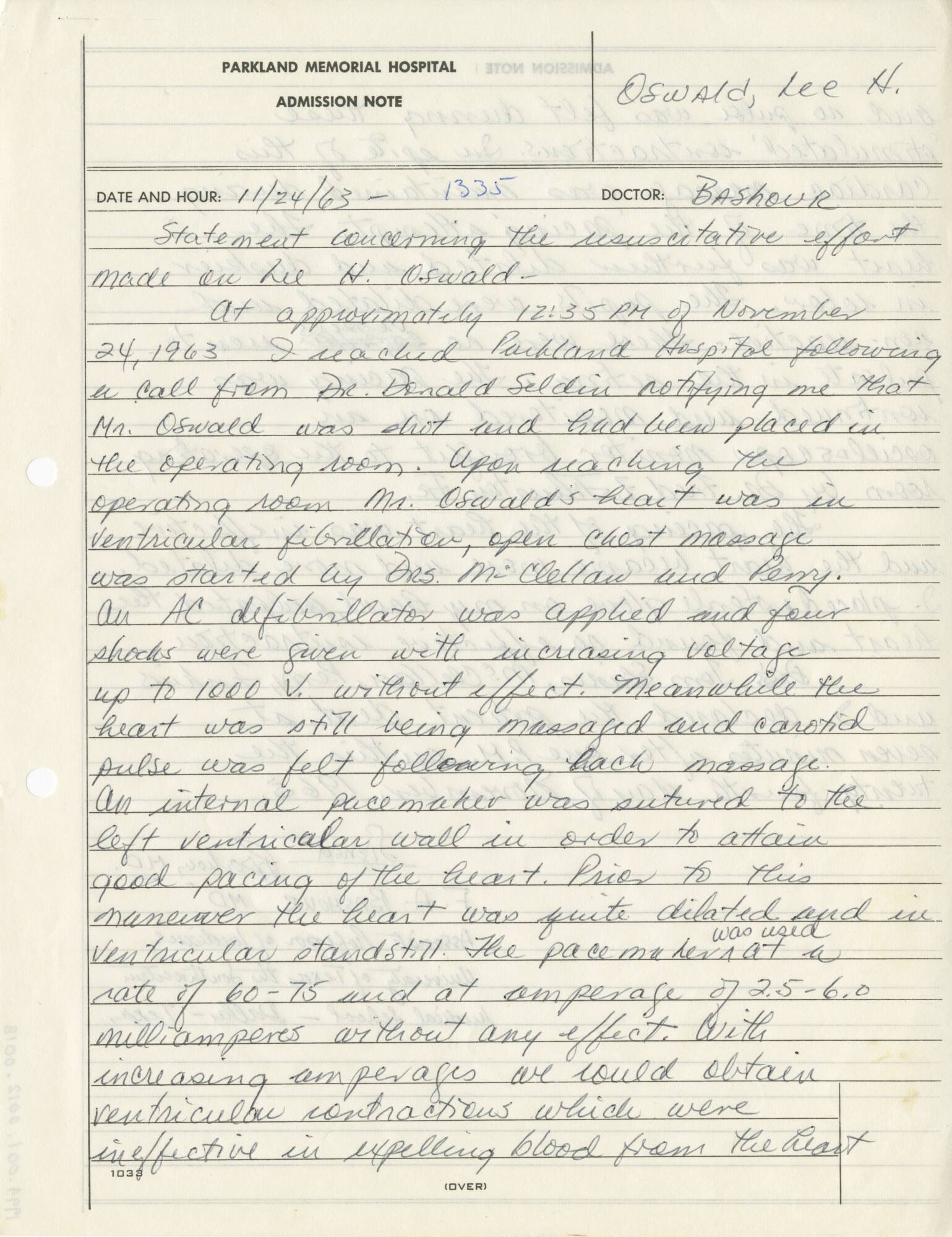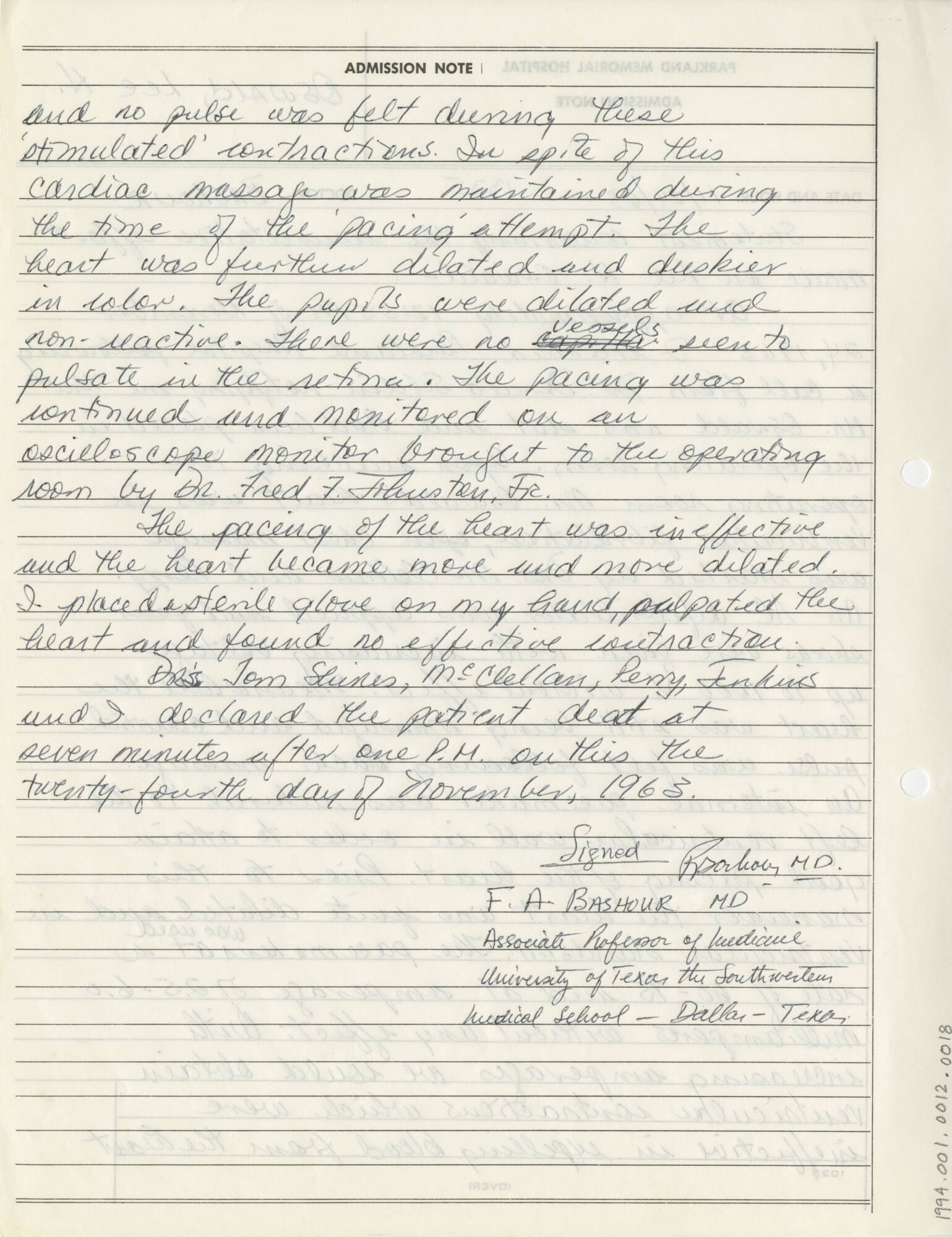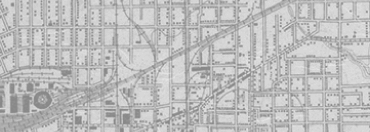


Back
Dr. Fouad A. Bashour's handwritten doctor's statement about treatment of Oswald
Original handwritten doctor's statement about patient Lee Harvey Oswald from Parkland Memorial Hospital. Written on Sunday, November 24, 1963, by Dr. Fouad A. Bashour, after surgical attempts to revive Oswald from a gunshot wound were unsuccessful. The statement, written on both sides of the page, reads:"Date and Hour: 11/24/63 - 13:35 Doctor: BashourStatement concerning the resuscitative effort made on Lee H. Oswald -At approximately 12:35 PM of November 24, 1963 I reached Parkland Hospital following a call from Dr. Donald Seldin notifying me that Mr. Oswald was shot and had been placed in the operating room. Upon reaching the operating room Mr. Oswald's heart was in ventricular fibrillation, open chest massage was started by Drs. McClellan and Perry. An AC defibrillator was applied and four shocks were given with increasing voltage up to 1000v. without effect. Meanwhile the heart was still being massaged and carotid pulse was felt following each massage. An internal pacemaker was sutured to the left ventricular wall in order to attain good pacing of the heart. Prior to this maneuver the heart was quite dilated and in ventricular standstill. The pacemaker was used at a rate of 60-75 and at amperage of 2.5-6.0 milliamperes without any effect. With increasing amperages we could obtain ventricular contractions which were ineffective in expelling blood from the heart, and no pulse was felt during these 'stimulated' contractions. In spite of this cardiac massage was maintained during the time of the 'pacing' attempt. The heart was further dilated and duskier in color. The pupils were dilated and non-reactive. There were no vessels seen to pulsate in the retina. The pacing was continued and monitored on an oscilloscope monitor brought to the operating room by Dr. Fred F. Thursten, Jr.The pacing of the heart was ineffective and the heart became more and more dilated. I placed a sterile glove on my hand, palpated the heart and found no effective contraction.Drs. Tom Shires, McClelland, Perry, Jenkins and I declared the patient dead at seven minutes after one P.M. on this the twenty-fourth day of November, 1963.Signed [?] MD.F.A. Bashour MDAssociate Professor of MedicineUniversity of Texas The Southwestern Medical School - Dallas - Texas"
Dr. Fouad A. Bashour's handwritten doctor's statement about treatment of Oswald
11/24/1963
Paper
11 x 8 1/2 in. (27.9 x 21.6 cm)
Parkland Hospital Collection/The Sixth Floor Museum at Dealey Plaza
1994.001.0012.0018
Dr. Bashour passed away on January 1, 2003. Like the late Dr. Malcolm Perry, Bashour was one of several Parkland Memorial Hospital physicians who remained very reluctant to speak publicly about the assassination weekend. His Parkland statement of activities and his brief Warren Commission testimony from March 25, 1964, provide the most comprehensive insight into his activities that weekend. - Stephen Fagin, Curator

Dr. Fouad A. Bashour's handwritten doctor's statement about treatment of Oswald
Original handwritten doctor's statement about patient Lee Harvey Oswald from Parkland Memorial Hospital. Written on Sunday, November 24, 1963, by Dr. Fouad A. Bashour, after surgical attempts to revive Oswald from a gunshot wound were unsuccessful. The statement, written on both sides of the page, reads:"Date and Hour: 11/24/63 - 13:35 Doctor: BashourStatement concerning the resuscitative effort made on Lee H. Oswald -At approximately 12:35 PM of November 24, 1963 I reached Parkland Hospital following a call from Dr. Donald Seldin notifying me that Mr. Oswald was shot and had been placed in the operating room. Upon reaching the operating room Mr. Oswald's heart was in ventricular fibrillation, open chest massage was started by Drs. McClellan and Perry. An AC defibrillator was applied and four shocks were given with increasing voltage up to 1000v. without effect. Meanwhile the heart was still being massaged and carotid pulse was felt following each massage. An internal pacemaker was sutured to the left ventricular wall in order to attain good pacing of the heart. Prior to this maneuver the heart was quite dilated and in ventricular standstill. The pacemaker was used at a rate of 60-75 and at amperage of 2.5-6.0 milliamperes without any effect. With increasing amperages we could obtain ventricular contractions which were ineffective in expelling blood from the heart, and no pulse was felt during these 'stimulated' contractions. In spite of this cardiac massage was maintained during the time of the 'pacing' attempt. The heart was further dilated and duskier in color. The pupils were dilated and non-reactive. There were no vessels seen to pulsate in the retina. The pacing was continued and monitored on an oscilloscope monitor brought to the operating room by Dr. Fred F. Thursten, Jr.The pacing of the heart was ineffective and the heart became more and more dilated. I placed a sterile glove on my hand, palpated the heart and found no effective contraction.Drs. Tom Shires, McClelland, Perry, Jenkins and I declared the patient dead at seven minutes after one P.M. on this the twenty-fourth day of November, 1963.Signed [?] MD.F.A. Bashour MDAssociate Professor of MedicineUniversity of Texas The Southwestern Medical School - Dallas - Texas"
Dr. Fouad A. Bashour's handwritten doctor's statement about treatment of Oswald
11/24/1963
Surgery
Doctors
Emergency care
Emergency room
Medical notes
Medical records
Medical team
Shires, George Thomas "Tom"
McClelland, Robert
Perry, Malcolm O.
Jenkins, Marion Thomas
Oswald, Lee Harvey
Parkland Hospital
Dallas
Paper
11 x 8 1/2 in. (27.9 x 21.6 cm)
Parkland Hospital Collection/The Sixth Floor Museum at Dealey Plaza
1994.001.0012.0018
Dr. Bashour passed away on January 1, 2003. Like the late Dr. Malcolm Perry, Bashour was one of several Parkland Memorial Hospital physicians who remained very reluctant to speak publicly about the assassination weekend. His Parkland statement of activities and his brief Warren Commission testimony from March 25, 1964, provide the most comprehensive insight into his activities that weekend. - Stephen Fagin, Curator









